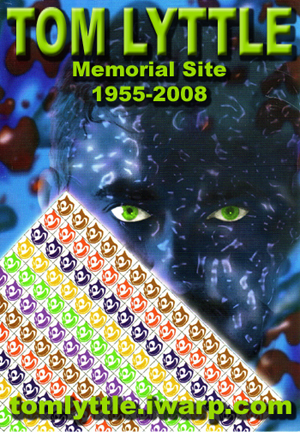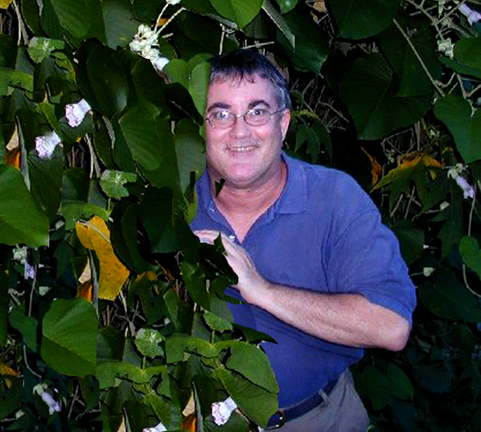Visit TOM LYTTLE MEMORIAL WEBSITE
Visit the Tom Lyttle Memorial Website
http://tomlyttle.iwarp.com/ Thomas Lyttle (b. 5-5-55 / d. 9-5-08) was Publisher and Editor of the kaleidoscopic journal PSYCHEDELIC MONOGRAPHS & ESSAYS, the books PSYCHEDELICS and PSYCHEDELICS REIMAGINED (Autonomedia). Later, he sold signed blotters of non-impregnated blotter art. His articles were published by Feral Press, Disinformation, High Times, Boing Boing, New Times, Paranoia, and many underground zines. His blotter art included signed editions by pop icons Albert Hofmann, Timothy Leary, Peter Fonda, Allan Ginsberg, Alex Grey, HR Giger, Laurence Gartel and other noted figures of the international underground. His interviews and performance art included such gags as pasting postage stamps all over himself to prevent arrest as First-Class Mail. Still, Lyttle's works were among the first to publically discuss DMT, Ibogaine, Ayahuasca, MDMA and the Holographic Paradigm. This memorial site is not an obituary but a celebration. Many have been in-formed by his scholarly and popular articles. Let him continue to inspire us. Madman or seer, Lyttle dared to make his unique contribution and left a footprint in this world and perhaps the next.
And let no sentiments of home detain us
The Cosmic Spirit seeks not to restrain us
But lifts us stage by stage to wider spaces."
-H. Hesse, The Glass Bead Game
Insert Sub Header Here
Go to Memorial Site
<> http://tomlyttle.iwarp.com/RANTS & RAVES
With his eccentric orbit, Lyttle became the Strange Attractor of an astonishing cast of diverse characters from the counterculture, science, academia, art world, parapsychology, media, entertainment, medicine, psychedelic intelligentsia and more. Showcasing the out-of-the-box thinking of others, he 'Forest Gumped' his way through the naked underbelly of the international underground while simultaneously serving Bilder-burgers to the global elite. He spent long periods of time in San Francisco, New York City and the Miami area.
ACID GREEN
Lyttle's works contributed to the 'acid greening' of the post-Postmodern cultural scene which has led back to serious psychedelic research. Psychedelics have been linked with non-ordinary perception or knowledge, healing, creativity and self-actualization. Modern studies are confirming the therapeutic value in psychedelic experience.
Psychedelic means 'mind expanding,' 'soul revealing,' or 'mind manifesting' and doesn't always refer to drug experience. It has to do with embodying the genius of human potential. John Curtis Gowan codified these experiences in the 1970s and his work, Development of the Psychedelic Individual *, remains a valuable reference along with others (James, Maslow, Grof, Tart, Wilber). Collective 'ego death' may be a viable model for profound changes in the global cultural landscape. We need bigger stories and bigger solutions. For some, psychedelics will remain both Universal Solvent and Panacea.
Insert Another Sub Header Here
episodes of altered consciousness. "
-Andrew Weil (1972:23)
A controversial writer, Tom Lyttle lived in the Bermuda Triangle and in a sort of Bermuda Triangle of the spotless mind. Mental illness ran in his family and he was not immune. His borderline behavior meant many of his friends gave him a mixed review or relegated him to their D-list. But in lucid cycles he profoundly regreted any acting out that hurt those he cared for most. A self-taught researcher, writer and artist, his unique pioneering body of work speaks for itself.
Thomas Lyttle was the publisher and editor of Psychedelic Monographs and Essays, a periodical that provided information to the counterculture at a time when mainstream publishing on the topic of illicit psychoactive drugs had slowed to a crawl. The first issue came out in the autumn of 1985, and the sixth and final issue appeared in 1993. PM&E evolved out of the newsletter the Psychozoic Press--An Informational Advisory and Communications Exchange Paper on Psychedelics, which first appeared in 1982. Editor Elvin D. Smith produced ten issues of the Psychozoic Press, and he continued to provide editorial input for PM&E until his death in 1988.
Following the conclusion of Lyttle's run as an editor and publisher, he created a "best of" compilation using selections from PM&E, titled Psychedelics: A Collection of the Most Exciting New Material on Psychedelic Drugs. Published by Barricade Books Inc. in 1994, Psychedelics saw wider distribution than PM&E had seen. The final book Lyttle edited was Psychedelics Reimagined, which contained writings by folks like Timothy Leary, Hakim Bey, Iona Miller, Otto Snow, Chris Bennett, John W. Allen, Jochen Gartz, and others.
Lyttle was an early collector and producer of LSD blotter art. He is the person who first conceived of asking psychedelic celebrities like Albert Hofmann, Timothy Leary, Sasha Shulgin, Annie Sprinkle, Peter Fonda, Alex Grey, Laurence Gartel, HR Giger, and others to autograph undipped sheets of blotter. This action inspired increased interest of blotter as an art form. Signed blotter became highly collectible, with rare sheets selling for hundreds or thousands of dollars. Before his death, Lyttle donated some of his more valuable pieces of blotter art to the Multidisciplinary Association for Psychedelic Studies, and the sale of autographed blotter raised around $20,000 for MAPS.
Watts (1972:354) uses "psychedelic" to mean 'mind manifesting.' Natural psychedelic experiences occur in a wide number of differing situations, involving certain common elements:
1) The attention of the subject is gripped, and his perception narrowed or focused on a single event or sensation;
2) which appears to be an experience of surpassing beauty or worth;
3) in which values or relationships never before realized are instantaneously or very suddenly emphasized;
4) resulting in the sudden emergence of great joy and an orgiastic experience of ecstasy;
5) in which individual barriers separating the self from others or nature are broken down;
6) resulting in a release of love, confidence, or power; and
7) some kind of change in the subsequent personality, behavior, or artistic product after the rapture is over.


